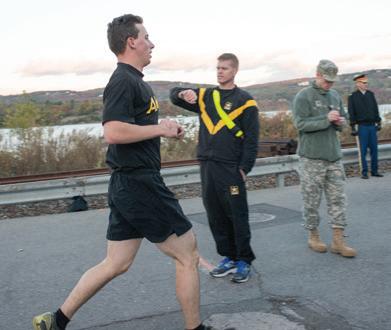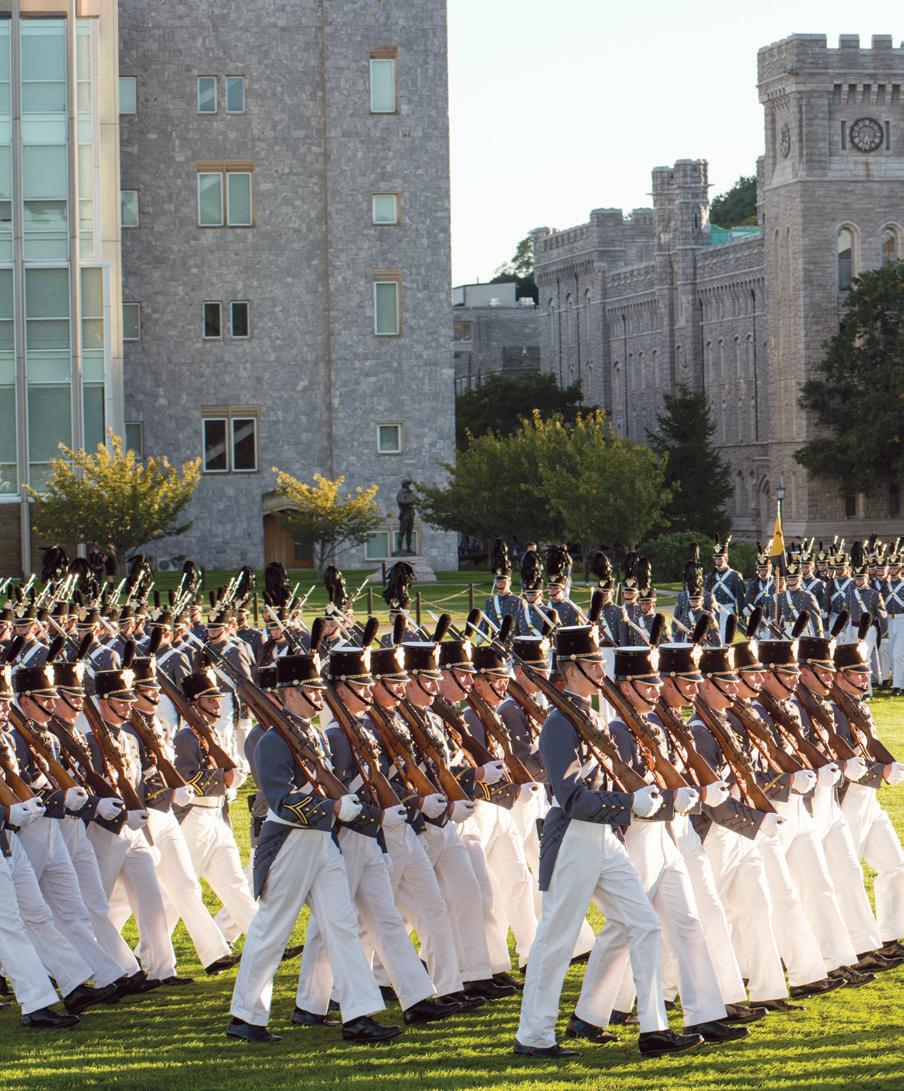
6 minute read
Physical USMA’s Physical Development Program: The Cornerstone of Combat Readiness
It’s 5:30am, and the Arvin Cadet Physical Development Center has just opened for business. One of its first “customers” is a Second Class cadet who has come to practice the shelf event of the Indoor Obstacle Course Test (IOCT), which competes with the rope climb event as the continual sore spot for cadets trying to pass the IOCT, a graduation requirement. A little later in the morning, more cadets arrive, including a group of female cadets from the Class of 2020 who are heading to PE116: Plebe Boxing, which is now a required course for all cadets at the Academy. And, in the afternoon, cadet company athletic teams descend on Arvin to play intramural basketball on one of its six indoor courts. From morning to night, physical activity never ceases at Arvin, just as it never ceases at the Academy at large, where one can witness company physical readiness training just as the sun is rising as well as squad runs around Post as the sun sets. It is all in preparation for what cadets will be doing in the Army.
“Regardless of branch, regardless of post, on their first day reporting as new second lieutenants, West Point graduates will be
Advertisement
By Keith J. Hamel, WPAOG staff
expected to do physically demanding tasks, guaranteed,” says Colonel Kevin Bigelman ’93, Acting Department Head for the United States Military Academy’s Department of Physical Education (DPE). “This fact makes what we do at DPE extremely relevant.”
DPE is in charge of USMA’s Physical Program, one of the four pillars of cadet development at the Academy. Its mission is to “develop warrior leaders of character who are physically fit and mentally tough by engaging cadets in activities that promote and enhance physical excellence.” Those activities fall into one of three types: instructional coursework, fitness testing, and competitive sports. A cadet’s performance in these three areas determine his or her Physical Performance Score (PPS), with coursework counting as 50 percent, fitness testing as 30 percent, and competitive sports as 20 percent. PPS is factored as 15 percent toward the Cadet Performance Score (along with the Academic Program Score at 55 percent and the Military Program Score at 30 percent), which determines a cadet’s overall ranking in his or her class.
The Physical Program portion of the 47-month West Point experience begins on R-Day with DPE personnel administering pull-up and flexed-arm-hang tests to get baseline physical performance numbers on all new cadets. DPE also plans and monitors an intense and progressive summer physical readiness training (PRT) for the six weeks of Cadet Basic Training (CBT), aiming to accomplish four overall goals: 1) prepare new cadets for the physical demands of summer training and the academic year’s physical education requirements, 2) introduce new cadets to the Army’s physical conditioning program, 3) foster positive behaviors and attitudes toward physical fitness, and 4) develop attributes of leadership, character, teamwork, self-confidence, and courage among new cadets.
For rising yearlings, DPE supervises special physical training events in Cadet Field Training (CFT) which are designed to challenge each Third Class cadet while fostering teamwork, courage, and pride. Lastly, summer training allows the upper-class cadet cadre to implement and execute PRT among their CBT and CFT units, which helps them develop their leadership skills through exposure to a variety of physical training methods and experiences. In each summer training PRT program, DPE emphasizes its motto: “Set the standard; maintain the standard.”
This motto continues into the academic year with DPE’s instructional coursework, which is graduated and progressive at both the course and program levels. Plebes in PE116: Plebe Boxing and PE117: Military Movement, for example, start with the basics (learning how to defend against the jab or learning jumping and landing techniques) before advancing to each course’s more recognizable events (sparring with a partner in the ring or vaulting over the horse). “It may be rough; it may look ugly, but each iteration builds confidence,” says Bigelman. This is important when trying to teach a cadet the defensive skills needed to take a punch or the techniques for stepping off a 6.5-meter platform into a pool during PE320: Survival Swimming. “All DPE courses have a fear management component,” says Bigelman, “and each one is designed to take cadets outside of their comfort zones.” By learning to manage their fear, cadets develop the mental toughness that DPE seeks to instill alongside physical fitness.
Each year of DPE coursework also builds progressively. In the Fourth Class program, cadets develop the self-confidence to meet the future physical requirements of the Academy, and, by the time they are firsties, they have studied the principles and theories to help them build a healthy, active physical fitness program for themselves and their units in the Army. In between, they develop both the functional fitness (agility, balance, coordination, power, and speed) and health-related fitness (muscular strength and endurance, body composition, flexibility, and cardiovascular stamina) that will help them as soldiers, and they participate in one of eighteen “Lifetime Physical Activity” courses (e.g., cycling, golf, racquetball, skiing, etc.), which are designed to instill in them a long-term commitment to physical development.
DPE’s dual focus on both functional and health-related fitness also comes into play in the annual fitness tests cadets must pass. The Brigade Tactical Department administers the Army Physical Fitness Test (APFT) to all cadets each semester, and DPE administers the IOCT to Third, Second, and First Class cadets at regular intervals each year. Cadets must successfully complete the
STAYING “ARMY STRONG”
The Army Physical Fitness Test (APFT) is administered each semester to every cadet by DPE staff and TAC officers. It has three components: 2 minutes of push-ups, 2 minutes of sit-ups, and a 2-mile run. As USMA graduates know, the APFT challenge is career-long.


APFT (push-ups, situps, and a timed two-mile run) to remain at the Academy, and they must meet the minimum performance standard of 3:30 (men) or 5:29 (women) on the IOCT in order to graduate. “The APFT may not be the best assessment of a cadet’s all-around fitness,” Bigelman admits, “but the 11-event IOCT— given that it tests certain skills (balance, agility, speed, etc.), requires anaerobic capacity, and features a mental toughness component (managing one’s fear of heights)—is a great test of soldier functional fitness.”
Perhaps the area of the Physical Program that takes the most holistic view of a cadet’s fitness level is the competitive sports program, which is comprised of three categories of competition: corps squad (run by the Director of Intercollegiate Athletics), competitive club (run by the Directorate of Cadet Activities), and company athletics (run by DPE). The competitive sports program was started by then Brigadier General Douglas MacArthur, Class of 1903, when he was Superintendent. Based on his experiences in World War I, MacArthur believed that cadets who took part in organized sport made the best soldiers. This belief created a philosophy that has spanned generations at the Academy: “Every cadet an athlete,” to which DPE has added, “and every athlete challenged.” Furthermore, as the “Whitebook,” the Physical Program’s official guide indicates, this philosophy has two outcomes: 1) to develop warrior athletes of character (“a team player who combines mental toughness, perseverance, and athletic skill with exemplary sportsmanship and fair play”) and 2) to build teams of significance (“a group of warrior athletes working as a single unit and demonstrating character, competency, commitment, courage, cohesion, and communication”).
On Monday through Thursday, from 4:15pm to 6:30pm (known as “MacArthur Time”), a cadet’s place of duty is “upon the fields of friendly strife.” All athletes in the three categories of competition are evaluated for their performance during this time based on the Character in Sports Index (CSI). The CSI factors in each cadet’s sportsmanship, mental toughness, winning spirit, unselfishness, coachability, attitude, playing ability, and competitive performance. “In general, we are trying to reward behavior on the field that is consistent with Army values,” says Bigelman.
Company athletics, which has approximately 2,800 cadet athletes and another 800 or so cadet leaders participating in one of five sports each semester, is the largest component of the competitive sports program, and it requires some 30 DPE sports educators to run this program every day. Competitive club athletics, which is offered through the Directorate of Cadet Activities and supervised through DPE, fields 16 club teams with roster spots for approximately 470 cadets. Finally, corps squad sports, run by the Directorate of Intercollegiate Athletics, has 28 teams, and the
PHYSICAL EDUCATION CURRICULUM AND STANDARDS:
All cadets are required to take a course sequence including Combatives and Military Movement, followed by Fundamentals of Personal Fitness and Combat Applications. Cadets must also take Survival Swimming and pass its test and pass the Indoor Obstacle Course Test (IOCT) in order to graduate.


athletes on these teams compete and win at the highest level possible for college sports, the NCAA.
Through instructional coursework, fitness testing, and competitive sports, DPE and the Physical Program allow cadets to demonstrate physical excellence over the course of their 47 months at the Academy and foster within each of them the desire to continue this optimal physical performance during their career in the Army and for the rest of their lives. Furthermore, from trying to score points against their opponent in the boxing ring to competing with their company athletics team against a common foe, DPE’s activities stress a winning ethos. “That’s what our business is all about,” says Bigelman. But, as he points out, for DPE, winning transcends the final score of any game or match: “It is paramount that we always affirm a ‘higher purpose’ that challenges cadets to reach their potential, as individuals, as team members, and as future Army officers.”
WOMEN’S BOXING: Introduced with the Class of 2020.
Combatives Class

ROPE CLIMB AND VAULT: Components of the Indoor Obstacle Course Test (IOCT) required for graduation.












